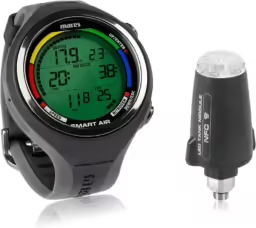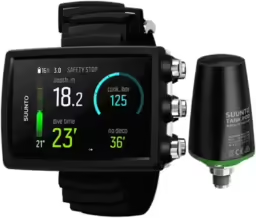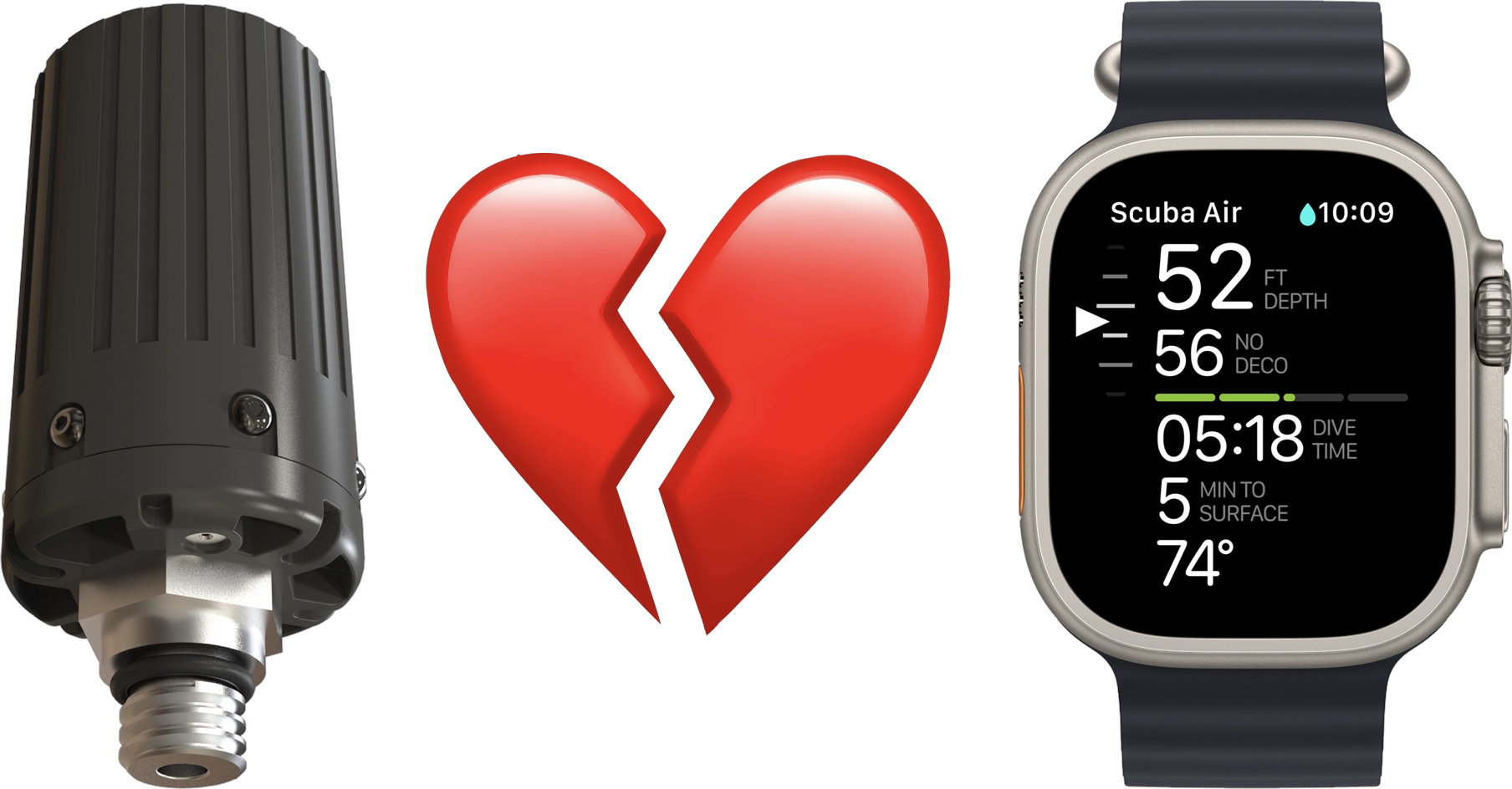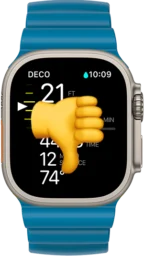Contents
This is a follow-up to my earlier review of the Apple Watch Ultra & Oceanic+ app, prompted by the fact that “apple watch ultra air integration” is one of the top search queries that brings traffic to my website.
The Apple Watch Ultra 2 changed essentially nothing about the underwater capabilities of the Apple Watch Ultra. It still does not support any kind of air integration – meaning, transmitter dongles attached to an HP port on your first-stage regulator that wirelessly report tank pressure to your dive computer(s). Air integration is super convenient and appealing as:
- It’s easier to read a bright, clear watch than most wired pressure gauges. Especially at a quick glance, which is important for encouraging you to check your air levels frequently.
- It can mean fewer hoses and dongles dangling about your person (although it’s not recommended to dive with a wireless gauge as your only air gauge, in case it fails during a dive even if only because the battery goes flat).
At the least it means less fiddling with hoses, as you can tuck your old-fashioned backup gauge neatly away somewhere and typically never have to look at it during a dive. - It allows your dive computer to issue alerts based on your air pressure. The most obvious of which is if your air pressure drops below a certain threshold (which you can typically configure based on your dive plan), but some dive computers have more advanced capabilities such as dynamically accounting for your current depth, air consumption rate, and decompression requirements.
- You can have multiple transmitters, representing multiple tanks (with potentially different mixes in them), all shown simultaneously together on a single screen.
And they don’t even all have to be on your own tank. A popular configuration is for dive buddies to hook into each other’s transmitters so they can double-check each other’s air. - It lets you log your air usage throughout a dive and for posterity. This can help you analyse your own dive fitness and behaviours, and optimise your air usage over time.
That the Apple Watch Ultra lacks this capability – tremendously appealing as it is to all serious divers – continues to be unsurprising, given the Apple Watch Ultra lacks many other features of advanced dive computers and is also a lot cheaper than most of them. Plus, the Apple Watch Ultra is designed for a much broader audience than just divers, and I suspect the vast, vast majority of Apple Watch Ultras never even go underwater outside of a bath.
I’d be very surprised if Apple add support for wireless pressure gauges at any point in the foreseeable future. And it’s almost certainly not a feature they could add retroactively to the first two generations, so if you have an Apple Watch Ultra (first or second gen) don’t hold your breath – if you want air integration, you need to get a different dive computer.
Alternatives
Most mid- to high-end dive computers support air integration, so if you have a favourite brand you can probably go with one of their offerings without too many issues. That said, there are two which seem most notable.
Shearwater Teric

These typically retail for around US$1,500 and are readily available online from Amazon, and practically every physical dive shop on the planet.
Shearwaters in general, and especially the Teric, are the dive computers I see most often amongst serious enthusiasts and professionals, and I don’t recall ever hearing a complaint about them (other than the same ‘complaint’ that I myself have, that I should have just bought the Teric to begin with rather than the Peregrine).
Shearwaters do work with 3rd party transmitters (and are often bundled with them), though it’s probably safest to use the official Shearwater Swift AI transmitter.
The downsides of the Shearwaters in general is that they omit some nice-to-have features, like heart-rate monitoring and GPS. But they’re not really intended to be used outside of the water anyway – they don’t have much functionality beyond a basic clock, otherwise – so you’ll typically pair them with a smart watch (like an Apple Watch).
Note that Shearwater recently released the Tern & Tern TX dive computers, which are (slightly) cheaper and lower-spec’d versions of the Teric that seem intended to fill out the price spectrum a little bit more, between the Peregrine and the Teric. Only the TX model supports air integration. I don’t see a compelling reason to go with the Tern TX over the Teric – and the Terns aren’t readily available from stores yet anyway.
Garmin Descent Mk2i

These typically retail for around US$2,000 and are also readily available online from Amazon. In my experience they’re not particularly common in physical dive shops (although you can likely have the shop order one in for you, in any case).
The main pitch of the Descent Mk2i over the Shearwater Teric is that it’s a more full-featured health & exercise watch, intended for full-time use in & out of the water, rather than as just a dive computer. As such, it incorporates all the features you’d otherwise expect from a Garmin smart watch, such as run tracking, heart-rate monitoring, GPS, etc.
I don’t recall ever actually seeing someone dive with one of these. Some lower-end Garmins, occasionally. Nonetheless the Descent line has been around for a long time and are well-reviewed. A big reason for their absence is that the Shearwater Teric has such a good reputation, strong market share, and is about $500 cheaper.
Beyond just price, however, the Garmin’s achilles heel – for iPhone users – is its more limited and less convenient integration to the Apple Health ecosystem, and Apple devices in general, compared to Apple’s own watches. To me it makes more sense to have an Apple Watch Ultra and a Shearwater Teric as you then have two dive computers, for extra safety. You can technically do a similar pairing with the Apple Watch Ultra and a Garmin, but it makes less sense since they’re more direct competitors, and it’s a substantially more expensive combination for little additional benefit.
Others
Budget option: Mares Smart Air

At the other end of the spectrum, there are surprisingly cheap options like the Mares Smart Air at as little as US$550. I have no personal experience with them, but Mares is a reasonable brand and the reviews are generally positive (but suggest that despite the air integration it’s still a pretty basic dive computer, with limited features and not the best user interface – which you could guess just by looking at the product photo since it clearly has an old-fashioned monochrome LCD display rather than the colourful OLED displays of higher-end options).
Mid-range option: Suunto Eon Core

Suunto make more mid-range options like the Eon Core at about US$1,200, and are a long-lived and pretty respected brand. I’ve never had a notable encounter with a Suuntu dive computer in the wild, but I’ve heard generally good things about them.
Highest specs: ScubaPro G3

ScubaPro also have high-end offerings, even more expensive than the Teric, such as the G3 at about US$1,650. I haven’t seen the G3 in particular in the wild, but ScubaPro are generally well-regarded for build quality and reliability (and the G3 pushes past all the other dive computers with a 300m depth rating, ensuring your dive computer will likely survive even though you did not).
Novel option: ScubaPro Galileo HUD

ScubaPro also make a dive computer that I find very interesting, although it might not be for everyone – the Galileo HUD at about US$1,550. I’ve actually seen these in use in the wild, and everyone I’ve encountered who has one swears by it. It’s easy to see the appeal – you have all your critical dive information available in your peripheral vision at all times, no matter what your hands are doing. That includes your compass bearing which can be super helpful for people with a poor sense of direction underwater (which, let’s face it, is most of us). There are some downsides: it’s a little more awkward to interact with than a wrist-mounted dive computer, some people might find the always-in-your-face display distracting, and it doesn’t fit all masks.

